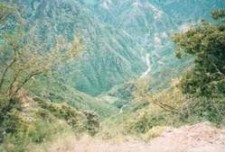Saying Goodbye in the Sierra Madre
Travel Stories: Jeff Biggers was living among the Tarahumara in Mexico's Copper Canyon when he was invited to a funeral for a local woman. Amid the sorrow and song, he peeked at "the other side."
01.23.07 | 1:00 PM ET
 Photo by Carla Paciotto.
Photo by Carla Paciotto.Alfonzo was standing by the cemetery rock wall, weeping with a crowd of men who had been drinking and grieving for the past 48 hours. They carried their sombreros or ballcaps in their hands; their hair had been molded like clay.
“Pancho,” he said to me, motioning at the banjo strapped on my shoulder, his hand raised in a vaguely Italian gesture of pronouncement. “We need to talk.” Alfonzo’s face unhinged; he couldn’t finish his sentence. He began weeping.
“Country, Pancho, country,” demanded Cornelio, a stocky older man who lived near our cabin. He was clearly the person most affected by country music in the Sierra Madre, also known as Copper Canyon. He once heard a song by Johnny Cash during a rare visit to Chihuahua City. The English word “country” had remained with him ever since. After a long drinking bout, he would often pound on our door at dawn and call out, “country, country, Pancho, get out here and play some country.” I would see him the following day. He would nod, I would nod, but neither of us would utter a word, as if we hardly knew each other.
A young village woman had died in Chihuahua City giving birth. She was working as a maid to a Mexican family, a common job for young Raramuri/Tarahumara women; her husband had found day jobs making adobe bricks. They lived in one of the shantytowns or colonias on the outskirts of the dusty city, which was now only a four-hour bus ride from Creel, a nearby mountain town in the Sierra Madre.
Without a priest, the locals had prodded a visiting Mexican carpenter into service, who changed into his good pants and clean shirt, and then offered some verses of solace and led the chants of the rosary at the mission. After two days of viewing in the home of the mother-in-law, the burial took place in the graveyard, referred to in our village as the pantheon.
Following a narrow trail along the cornfields, I cut behind the mission walls and slowly made for the log cabin on the other side of the hollow. Sweeps of pines and towering canyon walls served as borders for fields of corn.
I had never been to a round-the-clock home viewing before. A brigade of kids and ragged dogs met my entrance at the dirt clearing around the cabin. A collection of corn cobs littered the grounds, like the corn cobs and mounds found at 12th century Anasazi sites in my childhood haunts in Arizona. Several older men, including Alfonzo, El Chapareke and Bernabe, were chatting outside. A few others sat quietly on benches made of split logs. I was greeted with the Raramuri handshake—that dusting of the palms of our fingers—and then waved inside.
Despite the blaring um-pah-pah of norteņo music on a boom box in the corner, an air of regret hovered inside the sparse mourning room. Women huddled around the coffin in the emptied chamber. The variance in their dresses struck me; on one side sat those in home-stitched colorful skirts and matching tops and scarves, wearing huaraches, and on the other side sat women in polyester skirts, blouses, and plastic shoes. All the women were portly figures.
I spent a few minutes staring at the young woman. Her death was a horrible reminder of modernity’s price for this community. Many Raramuri women made up one of the last indigenous groups in the world that still delivered their babies on their own, sometimes in the forests. One friend once saw a woman cut the umbilical cord of her child with a piece of broken glass. The girl in the coffin had actually gone to the hospital in Chihuahua City for her delivery. I made my peace and departed.
The funeral, Bernabe told me outside the cabin, would also be a festive occasion. They were celebrating with the dead, inviting them to escort the departed soul away with them. Due to the fact that it took at least a week to prepare tesguino, tequila had broken through the dike of tradition and poured forth.
“After the funeral, the dead can leave us in peace,” Bernabe said. “Go away and not bother us.”
The Raramuri concept of immortality was so strong, Carl Lumholtz wrote, “that death means to them only a change of form.” According to William Merrill, a Smithsonian anthropologist who spent three years in a remote village for his groundbreaking study, “Raramuri Souls,” “People must overcome their feelings of sadness as soon as possible after the death of a loved one because if one’s souls are sad, they will want to leave the body to be with the deceased.”